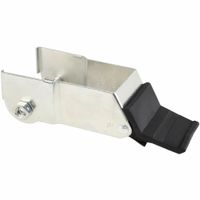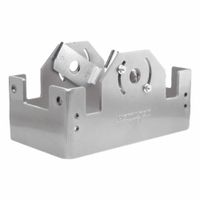Call +(254) 703 030 000 / 751 483 999 / 721 704 777
- Home
- Material Handling
- Casters Wheels
- Accessories For Casters Wheels
.....Read More
Frequently Asked Questions
What are the best accessories for enhancing caster performance?
To enhance caster performance, consider the following accessories:
1. **High-Quality Wheels**: Opt for wheels made from durable materials like polyurethane or rubber, which offer better traction, reduce noise, and provide smoother movement.
2. **Precision Bearings**: Use precision ball bearings to reduce friction and ensure smoother and more efficient rolling, which enhances the overall performance of the caster.
3. **Swivel Locks**: Install swivel locks to convert swivel casters into rigid ones when needed, providing stability and control in specific applications.
4. **Brakes**: Choose from various brake types such as side brakes, top-lock brakes, or total-lock brakes to secure the caster in place, preventing unwanted movement.
5. **Thread Guards**: Use thread guards to prevent debris from getting into the wheel bearings, which can cause damage and reduce performance.
6. **Shock Absorbers**: Incorporate shock-absorbing casters or add-on shock absorbers to reduce vibrations and protect sensitive equipment during movement.
7. **Leveling Casters**: Use leveling casters to adjust the height and maintain stability on uneven surfaces, ensuring optimal performance.
8. **Directional Locks**: Install directional locks to keep swivel casters moving in a straight line, improving control and maneuverability.
9. **Grease Fittings**: Ensure casters have grease fittings for easy maintenance, allowing for regular lubrication to keep them operating smoothly.
10. **Anti-Static Features**: For environments sensitive to static electricity, use casters with anti-static properties to prevent static build-up.
11. **Load Distribution Plates**: Use load distribution plates to evenly distribute weight across the caster, reducing wear and enhancing performance.
12. **Temperature-Resistant Components**: In extreme temperature environments, use casters with components that can withstand high or low temperatures without degrading.
These accessories can significantly improve the functionality, durability, and efficiency of casters in various applications.
How do floor locks work with casters?
Floor locks work with casters by providing a mechanism to stabilize and immobilize wheeled equipment or furniture. They are typically used in conjunction with casters on items like carts, workbenches, or medical equipment to prevent unwanted movement. Here's how they function:
1. **Design and Placement**: Floor locks are usually mounted on the underside of the equipment, near the casters. They consist of a foot pedal or lever, a locking pad, and a spring mechanism.
2. **Engagement**: To engage the floor lock, the user presses down on the foot pedal or lever. This action lowers the locking pad to the floor. The pad is often made of rubber or another non-slip material to ensure a firm grip on the floor surface.
3. **Stabilization**: Once the pad makes contact with the floor, it creates friction that prevents the equipment from moving. The pressure exerted by the spring mechanism keeps the pad firmly in place, effectively immobilizing the equipment.
4. **Disengagement**: To release the lock, the user lifts the pedal or lever, retracting the pad from the floor. This action allows the casters to roll freely again, enabling movement of the equipment.
5. **Compatibility**: Floor locks are compatible with various types of casters, including swivel and rigid casters. They are particularly useful on equipment that needs to be both mobile and stable at different times.
6. **Applications**: Commonly used in industrial, medical, and commercial settings, floor locks provide a simple and effective way to secure equipment without the need for complex braking systems.
By using floor locks, users can easily switch between mobility and stability, enhancing both safety and convenience in environments where equipment needs to be frequently repositioned.
What types of brakes are available for caster wheels?
Caster wheels can be equipped with various types of brakes to enhance safety and control. Here are the main types:
1. **Side Brake**: This is a simple lever mechanism located on the side of the caster. When engaged, it presses against the wheel to prevent it from rolling. It's easy to use and commonly found on light-duty casters.
2. **Tread Lock Brake**: This brake applies pressure directly to the tread of the wheel, effectively stopping it from moving. It's suitable for applications where a firm hold is necessary.
3. **Total Lock Brake**: This type locks both the wheel and the swivel simultaneously, preventing both rolling and pivoting. It's ideal for situations requiring complete stability.
4. **Directional Lock Brake**: This brake allows the wheel to roll but prevents it from swiveling. It is useful for maintaining a straight path when moving equipment.
5. **Central Locking System**: Often used in medical and industrial settings, this system allows multiple casters to be locked or unlocked simultaneously via a central pedal or lever.
6. **Tech Lock Brake**: A more advanced system that uses a foot pedal to engage a brake pad against the wheel, providing a secure hold. It's often used in heavy-duty applications.
7. **Pneumatic Brake**: Utilizes air pressure to engage the brake, offering smooth and controlled stopping power. It's typically used in specialized industrial applications.
8. **Electromagnetic Brake**: Activated electrically, this brake provides precise control and is used in high-tech or automated environments.
Each type of brake offers different levels of control and stability, catering to various needs and applications.
How do you install a lock kit on a caster?
1. **Gather Tools and Materials**: Obtain the lock kit, screwdriver, wrench, and any other tools specified in the lock kit instructions.
2. **Prepare the Caster**: Remove the caster from the equipment if necessary. Clean the caster to ensure proper installation of the lock kit.
3. **Identify Lock Kit Components**: Familiarize yourself with the components of the lock kit, such as the locking mechanism, screws, and brackets.
4. **Position the Locking Mechanism**: Align the locking mechanism with the caster. Ensure it fits snugly and is positioned correctly to engage with the wheel.
5. **Attach the Locking Mechanism**: Use the screws provided in the kit to secure the locking mechanism to the caster. Tighten the screws with a screwdriver or wrench, ensuring they are secure but not over-tightened.
6. **Test the Lock**: Engage and disengage the lock to ensure it functions correctly. The wheel should not move when the lock is engaged and should roll freely when disengaged.
7. **Reinstall the Caster**: If the caster was removed, reattach it to the equipment. Ensure it is securely fastened.
8. **Final Check**: Test the lock again after installation to confirm it operates smoothly and effectively.
9. **Repeat for Additional Casters**: If installing locks on multiple casters, repeat the process for each one.
10. **Maintenance**: Periodically check the lock for wear and ensure screws remain tight for continued functionality.
What are the benefits of using caster brakes?
Caster brakes offer several benefits, enhancing the functionality and safety of wheeled equipment. Firstly, they provide stability by preventing unwanted movement, which is crucial in environments where equipment must remain stationary, such as in medical facilities or workshops. This stability ensures safety for both the equipment and the users.
Secondly, caster brakes enhance control. They allow users to lock wheels in place, making it easier to handle and position equipment precisely. This is particularly beneficial in settings where precision is required, such as in laboratories or during assembly processes.
Thirdly, they contribute to safety by reducing the risk of accidents. By securing equipment in place, caster brakes prevent rolling, which can lead to collisions or tipping. This is especially important in busy environments like hospitals or factories where equipment is frequently moved.
Additionally, caster brakes are cost-effective. They reduce wear and tear on equipment by minimizing unnecessary movement, thereby extending the lifespan of both the casters and the equipment itself. This can lead to significant cost savings over time.
Moreover, they are versatile and can be used on a wide range of equipment, from office chairs to industrial machinery. This adaptability makes them a practical choice for various applications.
Finally, caster brakes are easy to use. Most designs allow for quick engagement and disengagement, often with a simple foot pedal, making them user-friendly and efficient in fast-paced environments.
In summary, caster brakes provide stability, control, safety, cost-effectiveness, versatility, and ease of use, making them an essential component in many industries.
Can floor locks be used on all types of flooring?
Floor locks are devices used to stabilize and secure mobile equipment, such as carts or machinery, by anchoring them to the floor. While they are versatile, their effectiveness and suitability can vary depending on the type of flooring.
1. **Hardwood Floors**: Floor locks can be used on hardwood floors, but care must be taken to avoid scratching or damaging the surface. Using floor locks with rubber or non-marking pads can help protect the floor.
2. **Tile Floors**: Floor locks are generally suitable for tile floors, but the tiles must be securely adhered to the subfloor to prevent cracking. Non-slip pads on the floor locks can enhance grip and prevent sliding.
3. **Concrete Floors**: These are ideal for floor locks due to their durability and strength. Floor locks can be used effectively without much concern for damage.
4. **Vinyl and Linoleum Floors**: Floor locks can be used, but there is a risk of indentation or marking. Using floor locks with softer pads can mitigate this risk.
5. **Carpeted Floors**: Floor locks are less effective on carpeted surfaces due to the lack of a solid grip. Specialized floor locks designed for carpets, which can penetrate the fibers for better stability, are recommended.
6. **Laminate Floors**: Similar to hardwood, laminate floors can be susceptible to scratches and dents. Using protective pads on floor locks is advisable.
In summary, while floor locks can be used on various types of flooring, the choice of floor lock and its design should be compatible with the specific flooring material to ensure effectiveness and prevent damage.
How do you choose the right caster accessories for your equipment?
To choose the right caster accessories for your equipment, consider the following factors:
1. **Load Capacity**: Determine the total weight the casters need to support, including the equipment and any additional load. Choose casters with a load capacity that exceeds this total weight to ensure safety and durability.
2. **Wheel Material**: Select wheel material based on the floor surface and environment. For smooth surfaces, hard materials like nylon or polyurethane are suitable. For rough or uneven surfaces, softer materials like rubber provide better shock absorption.
3. **Wheel Diameter**: Larger wheels roll more easily over obstacles and provide better mobility. Choose a diameter that balances maneuverability with the ability to handle the surface conditions.
4. **Mounting Type**: Decide between plate, stem, or bolt-hole mounting based on the equipment design. Ensure the mounting type is compatible with the equipment for secure attachment.
5. **Swivel vs. Rigid**: Swivel casters allow for greater maneuverability, while rigid casters provide stability and straight-line movement. Consider the movement requirements of your equipment to decide the appropriate combination.
6. **Braking Mechanism**: If stability is crucial, opt for casters with a reliable braking system. This is essential for equipment that needs to remain stationary at times.
7. **Environmental Conditions**: Consider exposure to chemicals, moisture, or extreme temperatures. Choose casters with corrosion-resistant materials or special coatings if necessary.
8. **Floor Protection**: If floor preservation is important, select casters with non-marking wheels to prevent damage or scuffing.
9. **Noise Levels**: For noise-sensitive environments, choose casters with soft, quiet-rolling wheels.
10. **Maintenance**: Consider the ease of maintenance and availability of replacement parts to ensure long-term functionality.
By evaluating these factors, you can select caster accessories that enhance the performance, safety, and longevity of your equipment.



